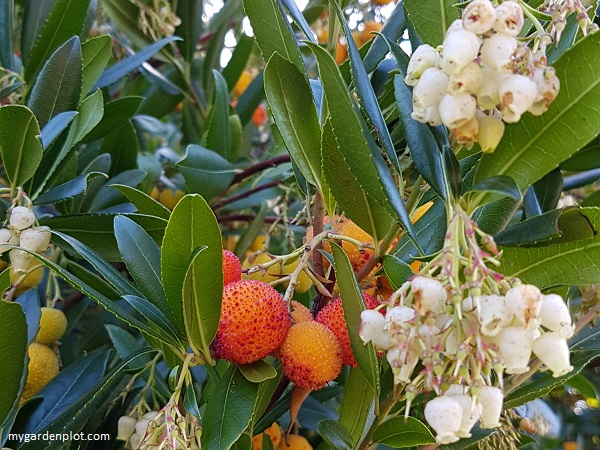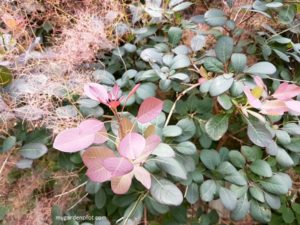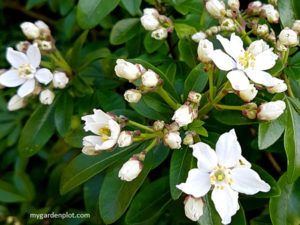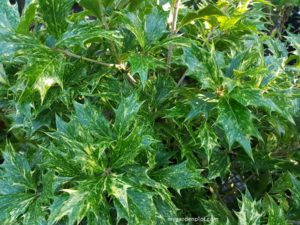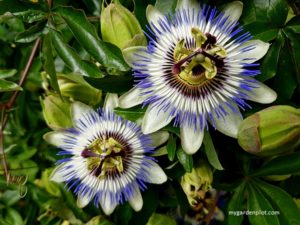About Arbutus Trees And Shrubs (Strawberry Tree, Madrone, Pacific Madrone, Killarney Strawberry Tree)
Arbutus trees and shrubs are evergreens providing year-round interest in a garden. Popular along the Pacific Northwest’s coastal region, there are many local neighbourhoods that one would be hard-pressed to not find a few of these trees in gardens. Native to Pacific Northwest, Europe, south-west Ireland, Anatolia (Asia Minor), and the Canary Islands where the Arbutus canariensis is known as madroño canario in Spanish – a token to my mum who was from Tenerife. There are various species and varieties, and most are slow-growing, low maintenance and drought tolerant. One favourite is the impressive Arbutus menziesii (madrone) with its ornamental bark, and equally stunning is the Arbutus unedo (strawberry tree) with its autumn white flowers and red berries. Learn below where to plant and how to grow and care for arbutus trees and shrubs.
Arbutus unedo (Strawberry Tree, Killarney Strawberry Tree, Mediterranean Strawberry Tree)
The Arbutus unedo or strawberry tree has an attractive bark and adds autumn interest with both white flowers and red berries contrasting against each other at the same time. The fruit is from the previous year’s flowers, and that is how you can see flowers and fruit at the same time. The flowers you see now will form fruit for next autumn. The tropical-looking berries change colour from green to yellow and orange and then finally to red. The berries are edible but not tasty, and as the name ‘unedo’ means ‘eat only one’ perhaps should suffice for any curious eater.
The A. unedo is native to Europe and south-west Ireland. It can grow to around 4.5-9 metres (15-30 ft) tall, but the A. unedo ‘Compacta’ is more of a shrub with a height of 2.5 metres (8 ft) with an equal spread. Another smaller cultivar suitable for a mixed border is the ‘Elfin King’ compact strawberry tree with masses of blooms and berries. It grows around 1.5-3 metres (5-10 ft) tall. Definitely one for adding colour in an autumn garden and continuing with the red berries and green foliage contrast in an early winter garden.
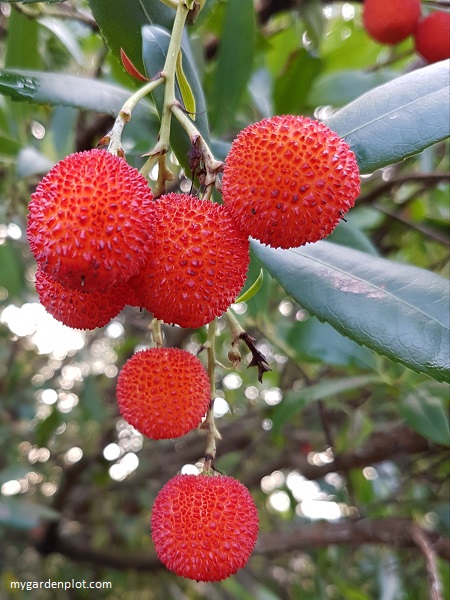
Arbutus menziesii (Madrone, Pacific Madrone)
Native to the Pacific Northwest, the Arbutus menziesii, madrone or Pacific madrone, can grow around 10-15 metres (33-50 ft) tall and with an equally large spread. It is an impressive evergreen tree valued for its large evergreen leaves and ornamental bark that peels off, exposing a smooth cinnamon-reddish bark underneath. The tree’s shape eventually takes a unique form, often blending into its environment with artistic leaning form. It has an interesting flower that blooms in early summer, followed by red fruit clusters, which remain until early winter. It needs a sunny sheltered site in colder regions. The madrone is not as hardy as the strawberry tree, and needs shelter from cold winds.
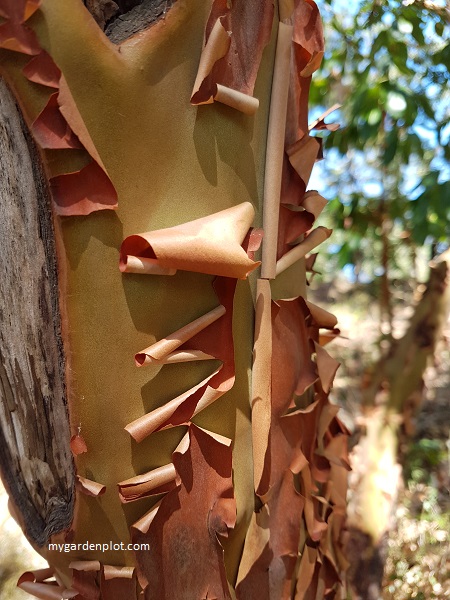
As with the flowering dogwood tree berries, the arbutus berries are an essential food source for wildlife. Birds are attracted to the arbutus trees and shrubs to eat the fruit during the autumn and early winter.
RELATED TOPIC: A Naturalist’s Garden And Pollinator Friendly Plants
Arbutus At A Glance
Type: Evergreen Tree or Shrub
Location: Full Sun
Seasonal Interest: Year-round Foliage And Ornamental Bark, Spring / Autumn Flowers, Autumn Berries
Size: 1.5-21 m (5-70 ft) with equal spread
When To Prune: Late Winter / Early Spring (see pruning notes below)
Plant Hardiness Zones: 7, 8, 9
Where To Plant And How To Grow Arbutus
Arbutus trees and shrubs thrive in full sun – a west or south-facing location is recommended. Arbutus prefers well-drained, acidic soil. However, the Arbutus unedo or strawberry tree can tolerate alkaline soil conditions while the A. menziesii or Madrone tree dislikes alkaline soil. Care needs to be taken if you apply dolomite lime to your lawn – keep the lime away from the roots of the A. menziesii or Madrone tree. Also, this applies to any acid-loving plants, such as rhododendrons, placed close to a lawn that requires dolomite lime treatment.
Arbutus succeeds best when planted in a protected site from cold winds. They are salt-tolerant and, once established, should not be overwatered. In the Pacific Northwest region, a woodland garden or coastal site that is warm and dry suits the arbutus tree perfectly.
It is important where you choose to plant an arbutus permanently, since they become very stressed when their roots are disturbed.
RELATED TOPIC: Buyer’s Guide On How To Choose Hand Pruners (Secateurs)
How To Prune Arbutus
Generally, no regular pruning is required for an arbutus other than removing deadwood or damaged branches. However, to showcase the arbutus’ ornamental bark, consider pruning a few branches that may obscure viewing it. Light prune of an arbutus is best done when it is dormant in late winter or early springtime.
RELATED TOPIC: Buyer’s Guide On How To Choose A Pruning Saw
Pests And Diseases That Affect Arbutus
Leafminers, fungal leaf spot, or scale insects can sometimes cause trouble. Generally deer resistant once mature. Deer will nibble on younger plants.

